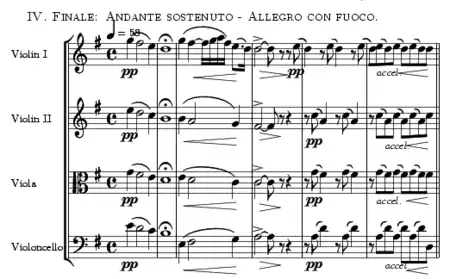String Quartet No. 13 (Dvořák)
Antonín Dvořák composed his String Quartet No. 13 in G major, Op. 106, (B. 192), between November 11 and December 9, 1895.[1] 1895 was an eventful year for him: he returned to Europe from America in April, and his sister-in-law (who had been his first love) died in May. Upon finishing No. 13, he took back up his No. 14 (Op. 105) in A-flat major, which he had begun before this quartet and finished it on December 30 of that year.[1] The quartet in G major was given its first performance by the Bohemian Quartet in Prague, on October 9, 1896.[1]
Structure
The string quartet contains four movements and lasts around 35 minutes. The movements are as follows:[2][1]
- Allegro moderato in G major and 2
4 time- The 'playful, fluttering principal theme with which the movement opens' is followed by a seemingly remote second theme and countermelody, all of which becomes subject to some 'masterly' development (Šourek).
- Adagio ma non troppo in E-flat major and 3
8 time- Described by Šourek as 'one of the loveliest and most profound slow movements in Dvorak's creation'.
- Molto vivace in B minor and 3
4 time- More like a rondo, with episodes in A flat major and D major for trios, than a typical scherzo (as is more often found in this place in a string quartet in the Romantic music era).
- Finale. Andante sostenuto — Allegro con fuoco
- The brief Andante sostenuto, which is in 4
4 "common" time, introduces a vigorous finale in 2
4 time, and interrupts it toward the end of the work. The finale is in the work's main key of G major.
- The brief Andante sostenuto, which is in 4
 |
(Dvořák's works have a confusing history of conflicting opus numbers, and so Jarmil Burghauser catalogued them more consistently in his book Antonín Dvořák; thematický katalog, bibliografie, přehled života a díla (Antonín Dvořák: Thematic Catalog, Bibliography, Life and Work), first published in 1960. It is because of this that Antonín Dvořák's compositions have Burghauser numbers used sometimes to identify them, with 192 used for this quartet.)[2]
References
- Otakar Šourek; Roberta Finlayson Samsour (Translator). The Chamber Music of Antonín Dvořák. Czechoslovakia: Artia. Retrieved 14 March 2018.
- String Quartet No.13, Op.106 (Dvořák, Antonín) -Section 'General Information' at imslp.org, accessed 14 March 2018
Sources (Hardcopy)
- Notes to the Chilingirian Quartet recording of the Quartet, made in 1991 (Chandos 8874)
- Dvořák, Antonín. Five Late String Quartets. New York: Dover Publications, 1986. ISBN 0-486-25135-7. Reprint of N. Simrock of Berlin publications - string quartets nos. 10–14 originally published 1879-96.
External links
- List of Dvořák Chamber works with Burghauser numbers
- Recording by the Huberman Quartet (archived on the Wayback Machine on 2006-08-31)
- String Quartet No. 13 (Dvořák): Scores at the International Music Score Library Project